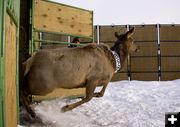

Releasing elk
An adult cow elk testing negative for brucellosis is released back to the Fall Creek elk feedground south of Pinedale as WGFD brucellosis biologist Jared Rogerson looks on.
|
|
Elk test and removal update
by Wyoming Game and Fish Department
February 5, 2009
Year four of the five-year elk test-and-removal pilot project got underway with the first week of the capture effort completed last week. The pilot project was one of 28 recommendations made by the Governor's Brucellosis Coordination Team in a comprehensive effort to deal with brucellosis in Wyoming. The members of this group were tasked to come up with effective long-term solutions to the brucellosis problem in Wyoming and new ideas on how to manage brucellosis.
Beginning this year, trapping efforts are being conducted at all three elk feedgrounds within the Pinedale elk herd--Muddy Creek, Scab Creek and Fall Creek feedgrounds--along the west slope of the Wind River range south of Pinedale. Trapping was done only at Muddy Creek feedground the first two years and expanded to include Fall Creek feedground last year.
Last week, personnel from the Wyoming Game and Fish Department and other agencies successfully trapped elk at all three feedgrounds. In all, agency personnel captured and handled 443 elk total. From those, 231 were test-eligible adult cows that were bled to test for exposure to brucellosis. Of the female elk bled, 16 tested seropositive for the disease and were removed from the population. Additionally, there were two known trapping-related mortalities. When handling such a large number of elk, capture mortality is always a possibility.
Personnel from the Wyoming Game and Fish Department and other agencies plan to conduct one more week of elk capture operations this winter starting the week of February 8th, 2009. Each trapping operation has typically involved between 50 and 60 personnel from Game and Fish and other agencies. Game and Fish personnel working at the Wyoming State Veterinary Laboratory in Laramie perform six different blood tests to determine which elk are most likely to have the disease.
In addition to the removal of seropositive elk, there is valuable research in brucellosis management evolving from this scientific experiment. Currently, blood samples from captured elk will only show if the animal has been exposed to Brucella abortus, the bacteria responsible for brucellosis infection. Tissue samples will be collected from all seropositive elk. These tissues will be cultured to determine if the slaughtered animals were actually infected and capable of transmitting the disease.
"Weíre hoping to find a better predictor of brucellosis culture positive elk from the six blood tests we used," said Hank Edwards, Wyoming Game and Fish wildlife disease specialist. "Research of this magnitude had never been possible until this project. Itís a very valuable component of the pilot project."
There is other important scientific research that is making use of the biological samples. Biologists are using fetuses removed from elk that are culture negative, or unable to transmit the disease, in a project examining scavenging rates on feedgrounds. This research recently led to implementation of the Target Feedground Project, an effort to reduce brucellosis prevalence in elk by using low-density feeding methods combined with shortening the length of the feeding season.
There is also cooperative research being conducted with the United States Geological Survey on the relationship between parasites, such as lungworms, and rates of brucellosis infections on feedgrounds. Some evidence suggests that parasites may play a role in disease transmission.
Elk feedgrounds have been active in northwest Wyoming for nearly a century. The first feedground established in Wyoming was at the National Elk Refuge in 1912. Today, there are 22 state-operated feedgrounds in Wyoming, in addition to the National Elk Refuge, which is operated by the US Fish and Wildlife Service. In an average year, around 13,000 elk are fed on state feedgrounds. Around 6,000 are fed on the National Elk Refuge each year.
Brucellosis transmitted to cattle herds from elk caused Wyoming to lose its brucellosis free status in 2004. Wyoming regained its Brucellosis Class Free status in September 2006, however cattle from a herd near Daniel were found to be positive for the disease in June of 2008. If a second Wyoming herd were to test positive, the state could again lose its brucellosis free status, thus limiting its ability to freely market its cattle. Ongoing research, along with other management practices, is an important part in eliminating brucellosis in wildlife and maintaining Class Free status for Wyoming.
The Governorís Brucellosis Coordination Team made the recommendation for the pilot test-and-removal experiment to last five years. Elk will be captured and tested at all three elk feedgrounds in the Pinedale elk herd this winter and the winter of 2009-2010, thus completing the five-year pilot project. A comprehensive review of the pilot project will be completed by the Governorís Brucellosis Coordination Team at that time.
|
